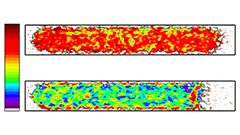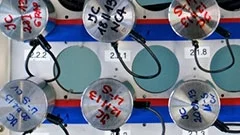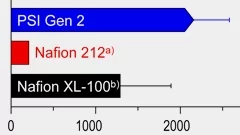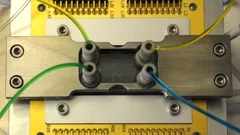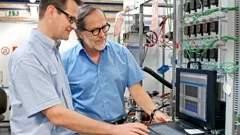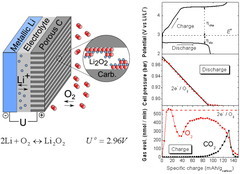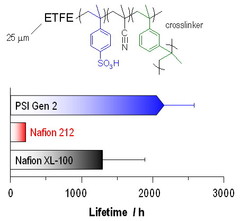News & Events
Ice in fuel cells imaged directly for the first time
Researchers from the Paul Scherrer Institute (PSI) have succeeded in imaging the distribution of frozen and liquid water in a hydrogen fuel cell directly for the first time. They applied a new imaging technique that uses successively two beams with different neutron energies to distinguish between areas with liquid water and those with ice extremely reliably. The method therefore opens up the prospect of studying one of the main problems of using fuel cells to power vehicles: ice can clog the pores in the fuel cells and affect their performance. The PSI scientists’ results will be published in the journal Physical Review Letters on 16 June 2014.
Fuel cell know-how from the Paul Scherrer Institute at the core of the SBB minibar
On 4 April 2014 SBB is to launch a new minibar model in its Intercity trains. A fuel cell system including know-how of the Paul Scherrer Institute will also be on board. It will ensure that despite the limited space the minibar will have enough power to brew capuccinos and latte macchiatos, too.
The Paul Scherrer Institute runs two of the energy competence centres of the Swiss government
As part of the Energy Strategy 2050 the Swiss government and parliament have decided to increase support for energy research in Switzerland. This includes the setting up of seven interuniversity networked Swiss Competence Centres in Energy Research (SCCERs). In the SCCERs ETH Domain institutions, the universities and the universities of the applied sciences are to join forces with industrial partners to develop new competencies and solutions in the decisive action areas of the shift in energy policy. The Paul Scherrer Institute PSI will act as the leading house in two of the SCCERs à storage and biomass à that have already been given the green light. They will begin their work in 2014.
Fuel cell membrane from the Paul Scherrer Institute better than its commercial counterparts
A novel polymer electrolyte membrane from the Paul Scherrer Institute PSI has demonstrated longer durability in a laboratory test than the best commercially available counterparts. The breakthrough was achieved by modifying a reasonably priced plastic film through radiation activation and subsequent attachment of functional constituents via a grafting reaction. The modified polymer is not only durable à it could also reduce the membrane production costs by 50 to 80 percent. The membrane could be used in applications such as hydrogen fuel cells or electrolysers for hydrogen production from water.
Zukünftige Computerchips mit "elektronischem Blutkreislauf"
Im Rahmen des Sinergia-Programms fördert der Schweizerische Nationalfonds das dreijährige Forschungsvorhaben REPCOOL. Unter der Leitung von IBM Research à Zürich arbeiten in diesem Projekt Wissenschaftler der ETH Zürich, des Paul Scherrer Instituts in Villigen und der Università della Svizzera italiana in Lugano gemeinsam an der Erforschung eines elektronischen Blutkreislaufs für zukünftige 3D-Computerchips. Vom menschlichen Gehirn inspiriert, entwickeln die Forscher ein Mikrokanalsystem mit einer elektrochemischen Flussbatterie, die 3D-Chipstapel gleichzeitig kühlen und mit Energie versorgen. Ultimatives Ziel ist die Entwicklung eines Supercomputers in PC-Grösse.This news release is only available in German.
Five times less platinum: fuel cells could become economically more attractive thanks to novel aerogel catalyst.
Fuel cells that convert hydrogen into power and only produce pure water as a by-product have the potential to lead individual mobility into an environmentally friendly future. The Paul Scherrer Institute (PSI) has been researching and developing such low-temperature polymer electrolyte fuel cells for more than 10 years and initial field tests have already demonstrated the successful use of these fuel cells in cars and buses. However, further research is still required to improve the durability and economic viability of the technology. An international team of researchers involving the PSI has now manufactured and characterised a novel nanomaterial that could vastly increase the efficiency and shelf-life of these fuel cells à as well as reduce material costs.
Dosing Differential Electrochemical Mass Spectrometry (D-DEMS) for Li-O2 Batteries
The high-energy rechargeable Li-O2 battery has been subject to intensive research worldwide during the past years. The Li-O2 cell mainly comprises a negative (e.g. Li metal) and positive (e.g. porous carbon) electrode separated by an electronically insulating, but Li+ conducting electrolyte layer. In order to study the cell chemistry, a differential electrochemical mass spectrometry setup based on a set of valves, a pressure sensor and a quadrupole mass spectrometer has been developed.
An ultrathin energy storage device made of carbon
For the discovery and characterisation of the miraculous material graphene à a layer of carbon exactly 1 atom thickà two Russian born physicists were awarded the Nobel Prize in 2010 and got a huge amount of media attention. Ever since graphene was first isolated, scientists all over the world have been rushing to find applications. Recently, scientists at the Paul Scherrer Institute PSI laid the foundations for a graphene-based super capacitor. With its help, the lifespan of batteries in hybrid cars could be extended significantly
Radiation grafted membranes developed at PSI outlast state-of-the art commercial membranes in the fuel cell
Components for the polymer electrolyte fuel cell (PEFC) are required to show high performance and durability under application relevant conditions. Furthermore, for commercial viability the materials and processes for component fabrication need to be of los cost. The polymer electrolyte membrane developed at PSI on the basis of the radiation grafting technique has the potential of being produced in cost-effective manner. In recent years, we have collaborated with the Belenos Clean Power to further develop the membrane to commercial competitiveness.
